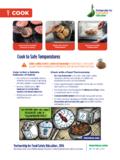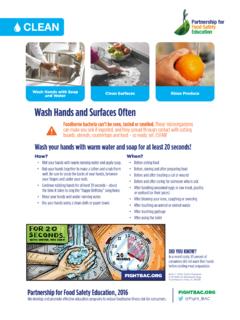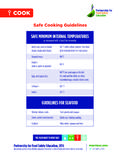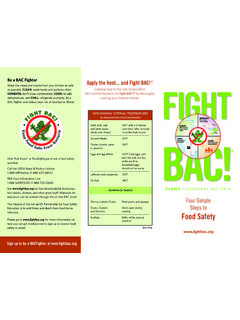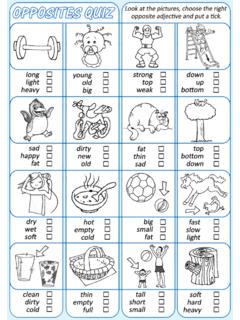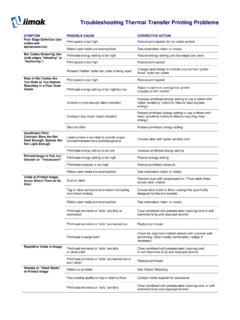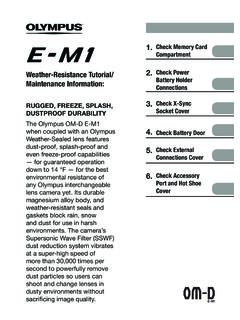Transcription of Changing Dirty Diapers - Fight Bac!
1 1 Available at A 2007 outbreak of shigellosis in Florida affecting 46 children was associated with multiple child-care facilities. The most important risk factor for illness was having a diaper changed. A 2010 E. coli outbreak at a Vancouver, Washington daycare led to the death of a four-year-old boy and four hospitalizations. Investigators believe risky diapering procedures may have been a factor. Public Health Reasons Fecal contamination during diapering is one route of transmission of gastrointestinal disease-causing pathogens. Children in child-care centers commonly excrete intestinal pathogens even if not presenting symptoms.
2 For example, noroviruses can be shed in the feces of children for at least 25 days after symptoms have stopped. Similarly, rotavirus can be shed for 25-57 days after the onset of diarrhea in a child. Continued shedding of pathogens in the feces of asymptomatic children can increase the transmission to healthy individuals. During diaper Changing , the diaper- Changing pad or the diaper- Changing table may come into contact with Dirty Diapers and fecal matter. When other children are placed on this common surface, contamination of their hands and clothes may occur. The children may then transmit the pathogens to environmental surfaces (such as shared toys or an eating table) that other children handle.
3 In a study by Jiang et al., a person with clean hands touched a contaminated ball, then touched a clean ball, and passed it down a line of people. The hands of the first three of five participants tested positive for the contaminant. After children s hands become contaminated, they may introduce pathogens into their bodies with mouthing behavior. Object-to-mouth contact is much greater among children than adults, and viruses and bacteria are more readily transferred from contaminated objects or hands directly to the mouth. Therefore, it is important to use a diapering procedure designed to reduce the risk of transferring pathogens from an infected individual to a healthy one.
4 Changing Dirty Diapers 2 Changing Dirty Diapers Available at Practices Diaper Changing Procedure Wash hands before bringing the child to the diaper Changing area (see Hand Hygiene For Care Providers fact sheet). Gather and bring the necessary items to the diaper Changing table if they are not already there: o non-absorbent paper liner large enough to cover the Changing surface from the child s shoulders to beyond the child s feet; o a fresh diaper; o wipes for cleaning a child's genitalia and buttocks, removed from the container or dispensed so the container will not be touched during diaper Changing ; o clean clothes and a plastic bag for any soiled clothes, if needed; o gloves, to be worn before handling the diaper or any soiled items.
5 And o when appropriate, a thick application of diaper cream dispensed from the container onto a piece of disposable material such as facial tissue, acquired before commencing with the diaper change. Carry the child to the Changing table, keeping soiled clothing away from you and any surfaces you cannot easily clean and disinfect after the change. Place the child on the diaper- Changing surface. o Always keep a hand on the child. o Remove the child s shoes and socks, so the child does not contaminate these surfaces with stool or urine during the diaper change. o Put soiled clothes in a plastic bag and securely tie the plastic bag to send home.
6 Unfasten the diaper, but leave it under the child. Lift the child s legs as needed to use disposable wipes to clean the skin on the child s genitalia and buttocks. Remove stool and urine by wiping from front to back, using a fresh wipe each time. Put the soiled wipes into the soiled diaper or directly into a plastic-lined, hands-free, covered trashcan. Remove the soiled diaper without contaminating any surface not already in contact with stool or urine. Fold the soiled surface of the diaper inward, and put soiled disposable Diapers in a plastic-lined, hands-free, covered trashcan. If reusable cloth Diapers are used, put the soiled cloth diaper and its contents (without emptying or rinsing) in a plastic bag to give to parents or into a plastic-lined, hands-free, covered can for the laundry service.
7 If gloves were used, remove them carefully and put them into a plastic-lined, hands-free, covered trashcan. Check for spills under the child. If there are any, use the paper that extends under the child s feet to fold over the Dirty paper so a fresh, unsoiled paper surface is under the child s buttocks. Slide a fresh diaper under the child. 3 Changing Dirty Diapers Available at Use a facial or toilet tissue to apply any necessary diaper creams, discarding the tissue in a covered, plastic-lined, hands-free trashcan. Fasten the diaper and replace clothing, socks, and shoes. Wash the child s hands first. Then wash hands (see Hand Hygiene For Care Providers fact sheet).
8 Cleaning a Child s Hands After Diapering Traditional Handwashing Use this method for children who can stand alone or be easily and safely supported at a hand sink: Wet the child s hands under clean, running water between 60 F and 120 F (16 C and 49 C). Help the child apply soap and rub hands together vigorously for 10 to 15 seconds covering all surfaces of the hands, fingers, and wrists. Rinse his hands with clean, warm, running water between 60 F and 120 F (16 C and 49 C). Immediately following handwashing, thoroughly dry the child s hands with one of the following: o individual, disposable, paper towels; o a continuous towel system that supplies the user with a clean towel; o a heated-air hand-drying device; and o a hand-drying device that employs an air-knife system that delivers high velocity, pressurized air at ambient temperatures.
9 Wiping Method If a child cannot stand or be safely supported at the sink, use the following method to wash the child s hands: wipe the child s hands with a damp paper towel moistened with a drop of liquid soap; wipe the child s hands with a paper towel wet with clean water; and dry the child s hands by wiping with a clean, dry paper towel. 4 Changing Dirty Diapers Available at AUTHORS: Cortney Miller, MS, Angela Fraser, PhD, Roman Sturgis, MFA (editor), Xi Chen, MS, Anna Saunders. Department of Food, Nutrition, and Packaging Sciences, Clemson University, Clemson, SC 29634 Published: March 31, 2013 Revised: February 27, 2013 This material is based upon work supported by the Cooperative State Research, Education and Extension Service, Department of Agriculture, under Agreement No.
10 2008-51110-04335, the National Integrated Food Safety Initiative of the Cooperative State Research, Education, and Extension Competitive Grants Program. Any opinions, findings, conclusions or recommendations expressed in this publication are those of the author(s) and do not necessarily reflect the view of the Department of Agriculture. References 1. American Academy of Pediatrics, American Public Health Association, & National Resource Center for Health and Safety in Child Care and Early Education. 2011. Standard diaper change procedure. Caring for our children: National health and safety performance standards; Guidelines for early care and education programs.
